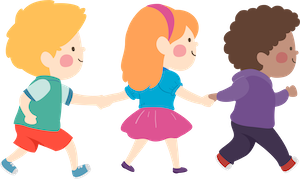Y1. Lesson 27. New note - la
Prior learning: So & mi, 5-line staff
Duration: 30 minutes
Materials:
Keywords: Beat, rhythm, singing, chanting, partners, rhymes, circle games.
Difficulty: ![]()
Prepare
Present
la
Practise
ostinato
 Melodic development
Melodic development
![]() Students discover a new note, la.
Students discover a new note, la.

- Students are seated and attentive.
- Ask the class to sing the first line of Bounce High and show the melodic contour as they do so.
- Ask a student how many beats there were [4]
- Ask which beat had the highest pitch or sound [2].
- Explain that this high sound is called la.
- Show the class how to sing Bounce High using the solfa syllables so - la- so - mi. Students should copy you.
- Show the hand sign for la. Ask students to copy you.
- Ask students to sing the first line of the song and show the hand signs for so, la and mi.
- Ask students to sing the second line of the song and use hand signs.
- Finally, ask the class to sing the song through.
 Rhythmic development
Rhythmic development
![]() Students discover matching notation to the song.
Students discover matching notation to the song.
- In this interactive learning activity, each student is provided with a printed copy of the worksheet.
- The worksheets and paper scissors are distributed to the students.
- Students are assigned to cut out the squares containing musical notation.
- The primary objective of this exercise is for the students to match the cut-out notation to the corresponding song.
- This process can lead to a lively and enjoyable atmosphere, even though it may also result in a bit of a mess.
- Alternatively, the worksheet can be projected onto the board.
- The class as a whole is then tasked with determining which song aligns with the presented musical notation.
- Ask students to tell you which song they wish to start with.
- Then ask students to sing the first line of the chosen song.
- Choose a student to show you the notation that belongs to the song. Offer gentle guidance where necessary.
- Repeat for the other songs.
- This approach promotes collective problem-solving and active engagement in music theory comprehension.
 Creative movement
Creative movement
![]() Students have fun and keep the beat in this circle game.
Students have fun and keep the beat in this circle game.
- Teach the song, and as you do so, walk in time with the beat.
- Students, in a circle, now copy you and march to the song, singing and keeping in time.
- When reaching the word 'stop', students must stand still, being careful not to move, or they are out of the game. Any child that moves is 'out' and has to move to the side of the class, but they should continue to sing along as the game progresses.
- For every rendition, ask a student if everyone should walk faster or slower and ask them to set the pace.
- The last person to stay in the game wins!

 Listening
Listening
![]() Students discover appropriate audience behaviour.
Students discover appropriate audience behaviour.
- Ask students: How should an audience behave at a School concert? Tennis match? Football game? School lesson? Movie?
- Teach that audience behaviour changes depending on the situation. For example, an audience is expected to cheer at a football game but not in the library!
- Discuss with the class what is the best behaviour when listening to the teacher or a student performing some music.
- Answers should include:
- Paying attention.
- Actively listen.
- Staying silent.
- Leaning forward.
- Eyes on the teacher/student.
- Sitting still.
 Visual learning
Visual learning
![]() Students
Students
- Many songs that will be familiar to students contain la, such as Bounce High, Ickle Ockle, Snail Snail, Lucy Locket, Bye Baby Bunting, Naughty Kitty Cat, etc.
- Reinforce the new knowledge that there is a note higher than so and mi, and it is called la.
- Explain that students have often used this note when they sing, but now they will discover where it is found on the staff.
- Teach that if so is in a space, la is on the line above; if so is on a line, then la is in the space above.
- Project the graphic to the left to show la on the staff.
 Instruments
Instruments
![]() Students use untuned percussion to play the beat and rhythm of a known classroom song.
Students use untuned percussion to play the beat and rhythm of a known classroom song.
- Divide the class in two.
- Distribute triangles and woodblocks to each half.
- Demonstrate how to keep the beat using a woodblock, showing how to hold the block and the beater correctly.
- Demonstrate how to hold a triangle and beater and how to make a clear sound.
- Begin by leading the class in singing the song.
- Repeat and invite students holding woodblocks to keep the beat as the class sings again.
- Demonstrate the rhythm on the triangle and lead the class in keeping the rhythm on the triangle.
- When both groups are secure (and this may take a few attempts) lead the class by conducting in duple metre.
 Part work
Part work
Students practise rhythm and ostinato.![]()
- Students are seated in a circle.
- The song is used to develop students' ability with rhythmic ostinato.
- Lead the class in singing the song and, when finished, announce that students will practice their rhythm and ostinato skills.
- Ask the girls to clap the rhythm while the boys clap a ti-ti ta ostinato as they sing.
- When secure, repeat again with the girls clapping the ostinato and the boys clapping the rhythm.
- The rhythm should be similar to that on the audio player.
 Assess
Assess
Suggested lessons
Y1. Beat II

Y1. Beat III

Y1. Beat IV

